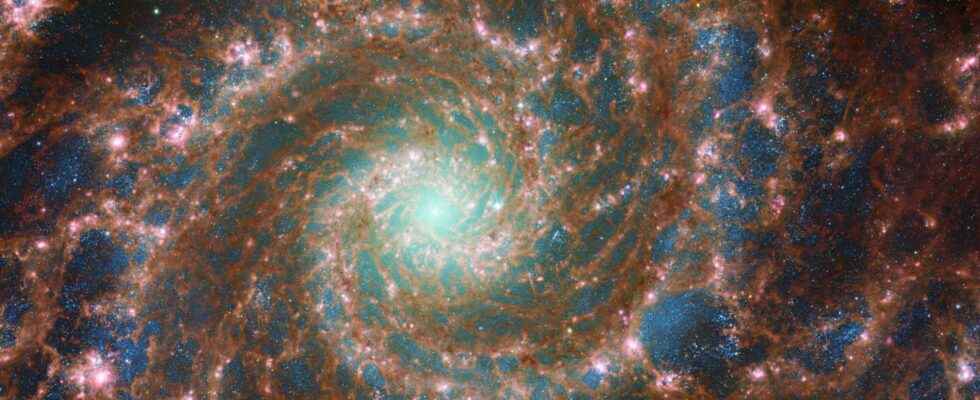The spiral galaxy M74, also known as the Phantom, was recently scanned by James-Webb as part of the Phang program. The space telescope reveals to us the internal structure of this galaxy seen from the front and which looks a lot like ours. The image was combined with those obtained in other wavelengths by Hubble. The fascinating result enriches our vision and our understanding of what is going on within a galaxy.
A month and a half ago, humanity discovered, amazed, the all first images of James-Webbthe kick-off of his scientific observations of the cosmos. A few days later, it was the turn of Jupiter to be his target (see the latest versions treated with talent by Judy Schmidt) and the data and images of the gas giant are beautiful.
A new cosmic object, iconic to say the least and well known to astronomers amateurs has just been observed by the powerful telescope: M74 a.k.a Messier 74, also known as the Ghost Galaxy, and NGC 628. The observation detailed by James-Webb was made as part of the Phang program which aims to study 19 galaxies relatively close to our own and brimming with star-forming activity. Astronomers want to know all the secrets of these star forges, their connections to each other and to the large-scale galaxy.
A mirror galaxy
M74 is a magnificent spiral galaxy which is reminiscent of our Milky Way (whose structure is assumed to be similar) in its shape and dimensions: approximately 95,000 light years of diameter. Distant some 32 million light-years from Earth, it comes to us entirely from above, which is fortunate and makes it an object regularly visited by the largest telescopes in the world, on Earth and in space. .
It is the effervescence within it, as revealed by observations in different wavelengths for many years, which attracts much attention from researchers. Thanks to the keen eyesight of James-Webb in theinfraredastronomers now have a penetrating view of what’s going on inside, including its huge network of filaments of gas interconnected through the spiral arms of the galaxy and its center which shines a lot due to the high concentration of stars.
The image obtained with the camera Miri (Mid-InfraRed Instrument) of James Webb (above) is stunning in beauty and detail. James-Webb thus reveals to researchers all the underground activity of the galaxy, which is usually invisible (or bad) because it is dark, opaque and cold. They are, in a way, clouds of gases that smolder stars. Hundreds, thousands. It all starts with a embryo matter that condenses in the heart of darkness in these molecular clouds. And as you see, all these nebulae are interconnected and actually form a single, huge one across the entire galaxy. A bit like the blood system of an animal with its arteriesits veins and its vessels extended throughout the body and to the surface of the skin.
In this brilliantly processed image of Miri by Judy Schmidt, we see more dense and agitated regions, illuminated by swarms of young stars and voids carved out by the blast of supernovae. The most fertile parts of the spiral galaxy appear more red and bright. You are not dreaming, this is neither a ghost nor an illustration of a whirlwind psychedelic you’re looking at…but reality: the swirling web of the ghost galaxy.
Interested in what you just read?
